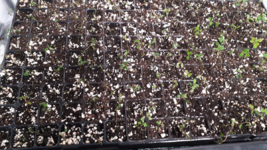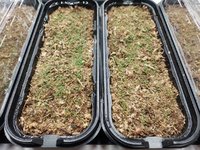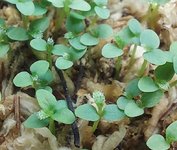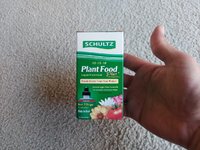I wish I had to space and time to do it now.
How big/old were they when you did the transplant into the cell tray?
Of course, if you don't have the space, you don't have the space.
I can take pictures of this tray next week. Away from my plants during the work week.
From my picture archive, this is a tray where the sowing was very dense:

A tray like this becomes kind of stagnant. They all try to grow taller and taller.
(It may actually be the tray I transplanted seedlings out of.)
Your tray will end up like this one, or many even denser.
Notice that for some reason the seedlings on the edges of the tray grow faster. It is very hard to judge genetics this early.
So once your tray looks like this, it is not so obvious to pick out the best growers. Any in terms of genetics, I see very little variation among very young seedlings (but clear variation from seedlings of different crosses).
Now this is not a fair comparison because the following seedlings were sown earlier (and also from a different cross), but if given space they grow like this:

Next weekend I can show you the 144 cell plug tray. But also show you densely sowed trays vs early transplants from that same tray, and how transplanting has given them the advantage.
You can always transplant. But it will be a more finicky work to transplant from a densely sowed tray like picture 1. You can still pull seedlings out. But they will lose some roots. And they had sub-optimal growth for a while.
Also, culling is even more work and harder to do. Because you need to pull out the most tiny seedlings, and a few decently sized ones for every good seedling. And even then you don't gain so much. So culling as a strategy is probably the least effective. The smaller ones you just abandon at some point when you are repotting the larger ones. You don't repot them and instead discard them.
No worries because this will work in the end. But it might be more optimal next time to sow 1/4th of the seeds early, so they have plenty of space. And then sow the rest very near the moment they can be moved outside. Then germinate them indoors for 2 weeks, and move them outside in the 200 cell trays.
They may also completely fill out a 200 cell volume once they have 6 or so true leaves. The seedlings on the second picture, I will move those to a 40 or 66 cell tray. Something like 4 by 4 cm would be great for seedlings. Some of my largest seedlings overwintered in 7x7cm pots. So with a 200 cell, expect to transplant again at some point during summer. Then they can overwinter in that tray.
If you have 3000 seedlings, you save a lot of time by only translating 2 times vs 4 times, for example.
I think that next year I will probably try to sow very dense in sphagnum once more. Then transplant to the 144 at germination (the stage you are at). And then transplant them into 5x5cm trays once I move them outdooors. And they then overwinter their first winter in that second tray.
The issue was that I don't have humidity domes that can cover the plug tray. But I now have a tent with a humidifier, so I think this will work now.
And sowing 1 seed into 1 cell of a plug tray is also not practical. Hence the transplant once the root or first leaf is visible.















